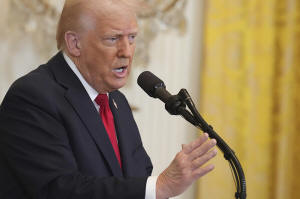Trump places 25% tariff on imported autos, expecting to raise $100
billion in tax revenues
[March 27, 2025] By
JOSH BOAK
WASHINGTON (AP) — President Donald Trump said Wednesday he was placing
25% tariffs on auto imports, a move the White House claims would foster
domestic manufacturing but could also put a financial squeeze on
automakers that depend on global supply chains.
“This will continue to spur growth,” Trump told reporters. “We'll
effectively be charging a 25% tariff.”
The tariffs, which the White House expects to raise $100 billion in
revenue annually, could be complicated as even U.S. automakers source
their components from around the world. The tax hike starting in April
means automakers could face higher costs and lower sales, though Trump
argues that the tariffs will lead to more factories opening in the
United States and the end of what he judges to be a “ridiculous” supply
chain in which auto parts and finished vehicles are manufactured across
the United States, Canada and Mexico.
To underscore his seriousness about the tariffs directive he signed,
Trump said, “This is permanent.”
Shares in General Motors fell roughly 3% in Wednesday trading. Ford's
stock was up slightly. Shares in Stellantis, the owner of Jeep and
Chrysler, dropped nearly 3.6%.
Trump has long said that tariffs against auto imports would be a
defining policy of his presidency, betting that the costs created by the
taxes would cause more production to relocate to the United States while
helping narrow the budget deficit. But U.S. and foreign automakers have
plants around the world to accommodate global sales while maintaining
competitive prices — and it could take years for companies to design,
build and open the new factories that Trump is promising.

"We’re looking at much higher vehicle prices,” said economist Mary
Lovely, senior fellow at the Peterson Institute for International
Economics. “We’re going to see reduced choice. ... These kinds of taxes
fall more heavily on the middle and working class.’’
She said more households will be priced out of the new car market —
where prices already average about $49,000 — and will have to hang on to
aging vehicles.
The tariffs on autos would start being collected on April 3, Trump said.
If the taxes are fully passed onto consumers, the average auto price on
an imported vehicle could jump by $12,500, a sum that could feed into
overall inflation. Trump was voted back into the White House last year
because voters believed he could bring down prices.
Foreign leaders were quick to criticize the tariffs, a sign that Trump
could be intensifying a broader trade war that could damage growth
worldwide.
“This is a very direct attack,” Canadian Prime Minister Mark Carney
said. “We will defend our workers. We will defend our companies. We will
defend our country.”
In Brussels, European Commission President Ursula von der Leyen
expressed regret at the U.S. decision to target auto exports from Europe
and vowed that the bloc would protect consumers and businesses.
“Tariffs are taxes — bad for businesses, worse for consumers equally in
the U.S. and the European Union,” she said in a statement, adding that
the EU’s executive branch would assess the impact of the move, as well
as other U.S. tariffs planned for coming days.
As Trump announced the new tariffs, he indicated that he would like to
provide a new incentive to help car buyers by allowing them to deduct
from their federal income taxes the interest paid on auto loans, so long
as their vehicles were made in America. That deduction would eat into
some of the revenues that could be generated by the tariffs.
The new tariffs would apply to both finished autos and parts used in the
vehicles, according to a White House official who spoke on condition of
anonymity to discuss the taxes on a call with reporters. The tariffs
would be on top of any existing taxes and were legally based on a 2019
Commerce Department investigation that occurred during Trump's first
term on national security grounds.
[to top of second column] |

President Donald Trump speaks at a reception celebrating Women's
History Month in the East Room of the White House, Wednesday, March
26, 2025, in Washington. (AP Photo/Jacquelyn Martin)
 For autos and parts under the USMCA
trade pact applying to the United States, Mexico and Canada, the 25%
tariffs would only apply to non-U.S. content.
The administration is reasoning that there is excess capacity at
U.S. automakers that will enable them to ramp up production to avoid
the tariffs by manufacturing more domestically, with the official
noting that automakers have known since the Trump campaign that
tariffs were coming.
The auto tariffs are part of a broader reshaping of global relations
by Trump, who plans to impose what he calls “reciprocal” taxes on
April 2 that would match the tariffs, sales taxes charged by other
nations.
Trump has already placed a 20% import tax on all imports from China
for its role in the production of fentanyl. He similarly placed 25%
tariffs on Mexico and Canada, with a lower 10% tax on Canadian
energy products. Parts of the Mexico and Canada tariffs have been
suspended, including the taxes on autos, after automakers objected
and Trump responded by giving them a 30-day reprieve that is set to
expire in April.
The president has also imposed 25% tariffs on all steel and aluminum
imports, removing the exemptions from his earlier 2018 taxes on the
metals. He also plans tariffs on computer chips, pharmaceutical
drugs, lumber and copper.
His taxes risk igniting a broader global trade war with escalating
retaliations that could crush global trade, potentially hurting
economic growth while raising prices for families and businesses as
some of the costs of the taxes get passed along by importers. When
the European Union retaliated with plans for a 50% tariff on U.S.
spirits, Trump responded by planning a 200% tax on alcoholic
beverages from the EU.
Trump also intends to place a 25% tariff on countries that import
oil from Venezuela, even though the United States also imports oil
from that nation.
Trump's aides maintain that the tariffs on Canada and Mexico are
about stopping illegal immigration and drug smuggling. But the
administration also wants to use the tariff revenues to lower the
budget deficit and assert America's preeminence as the world's
largest economy.
The president on Monday cited plans by South Korean automaker
Hyundai to build a $5.8 billion steel plant in Louisiana as evidence
that tariffs would bring back manufacturing jobs.

Slightly more than 1 million people are employed domestically in the
manufacturing of motor vehicles and parts, about 320,000 fewer than
in 2000, according to the Bureau of Labor Statistics. An additional
2.1 million people work at auto and parts dealerships.
The United States last year imported nearly 8 million cars and light
trucks worth $244 billion. Mexico, Japan and South Korea were the
top sources of foreign vehicles. Imports of auto parts came to more
than $197 billion, led by Mexico, Canada and China, according to the
Commerce Department.
___
Associated Press writers Paul Wiseman in Washington and Rob Gillies
in Toronto contributed to this report.
All contents © copyright 2025 Associated Press. All rights reserved |